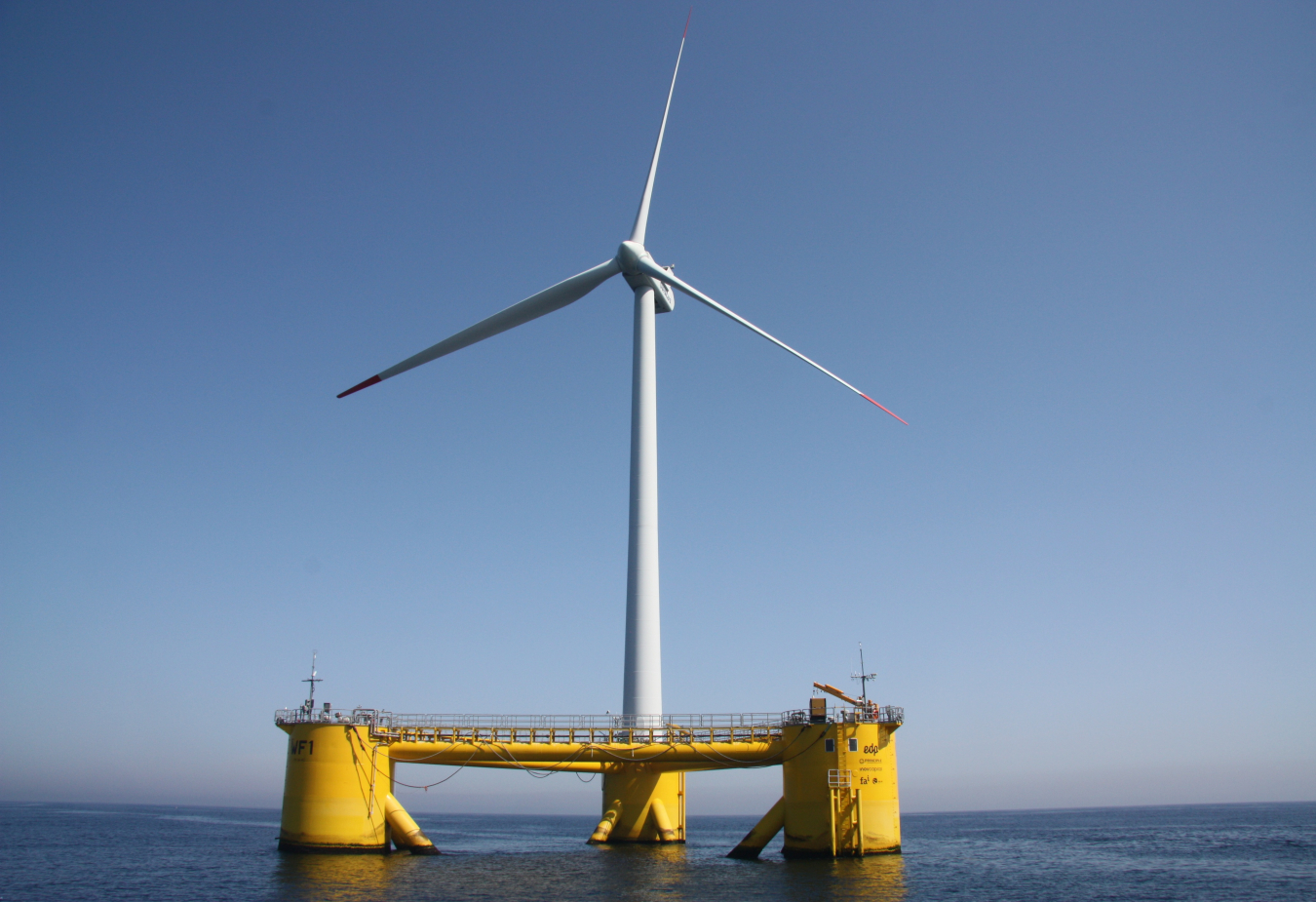A new scalable offshore floating wind system provides novel solutions to cut costs and overcome challenges of deepwater offshore environments.
Wind Energy Technologies Office
October 21, 2019System offers potential to reduce costs and increase economic viability of deepwater offshore wind
U.S. offshore wind installations in ocean waters deeper than 60 m could supply more than 1,200 GW of electric-generating capacity to the nation’s electricity system. At the same time, relatively high capital expenditures for deepwater wind—approximately 35% of which can be attributed to substructure and installation expenses—challenge the economic viability of this resource. Innovative technology developed by researchers at DOE’s NREL has the potential to reduce costs by simplifying construction and maintenance logistics for deepwater wind systems in challenging offshore marine environments.
This article is part of the
The new scalable offshore floating wind system, named “SpiderFLOAT” for its modular components that resemble spider legs, is designed to substantially reduce expenses for deepwater substructures, driving down the cost of deepwater wind energy. Ultimately, researchers hope this could make deepwater systems competitive with fixed-bottom offshore wind power plants.
Designed as a support platform for wind turbines ranging from 6 to more than 20 MW, SpiderFLOAT’s radical new approach could enable high-volume manufacturing and overcome transportation constraints that might otherwise lead to design compromises. SpiderFLOAT is also designed to reduce material content and related substructure costs, while its simplification of routine maintenance requirements supports lower operation and maintenance costs.
“Historically, floating substructures have drawn heavily on designs for oil and gas projects. We realized that an opportunity existed to completely rethink the current approach and tailor the design to the challenges of floating offshore wind, enabling more effective capture of the planet’s abundant deepwater wind resources,” said NREL Research Engineer and SpiderFLOAT Principal Investigator Senu Sirnivas.
SpiderFLOAT’s innovative substructure design and use of materials best suited for the requirements of each component—combined with modular elements, local supply chains, automated and on-site manufacturing, and reduced materials requirements—can help make offshore systems more cost competitive. This could help tap the vast energy potential of deepwater markets, including the United States’ West and Northeast Coasts, the Gulf of Mexico, and Hawaii, as well as locations in Europe and Asia.

WindFloat by Principle Power, Inc. is one example of the platform systems developed from oil and gas technology currently available to offshore floating wind project developers. Photo by NREL
The SpiderFLOAT substructure reduces costs and improves performance by minimizing the use of steel and limiting transmission of wave motions to the wind turbine. The flexible technology can also be paired with a range of turbine designs and anchoring methods to accommodate numerous system configurations.
SpiderFLOAT’s modularization and simplified mooring allow for partial on-site manufacturing and easy towing of the entire system for installation and maintenance. In addition, by minimizing construction activities at the installation site, SpiderFLOAT helps reduce pile driving and other environmentally sensitive activities typically associated with fixed-bottom installations.
The NREL research team that developed the SpiderFLOAT technology is now working with industry partners to prepare the system for commercialization. SpiderFLOAT began as an internal NREL Laboratory Directed Research and Development project, with funding designated by lab leadership to launch innovative technical and scientific projects.

Three-dimensional model of the slender, multibody SpiderFLOAT platform configuration. Graphic from NREL
WETO then selected the project for participation in the DOE Energy I-Corps and Technology Commercialization Fund programs, which accelerate the commercial deployment of national lab-developed technologies by helping build industry partnerships and bring prototypes to market. Energy I-Corps industry mentor and offshore wind developer Trident Winds helped identify developers’ performance parameters and cost requirements related to floating wind systems and pathways to commercialization.
"I-Corps allowed us to interview nearly 75 stakeholders within the floating wind community," said NREL Senior Research Engineer and SpiderFLOAT design team member Rick Damiani.
His colleague, NREL Research Engineer Fabian Wendt, a fellow SpiderFLOAT collaborator, added, “It provided us with terrific insight about the challenges and needs of the industry."
The work on details of the modular design and manufacturing strategy continues with the aim of future certification and licensing. Subsequent research will consider new options for system controls. As part of the Technology Commercialization Fund phase of the project, in the coming months the team will conduct a subscale model evaluation of the patent-pending technology at a wave basin in the United States.
-
 A2e initiative addresses the need to have reliable, applicable wind data by establishing and funding the Data Archive and Portal (DAP).
A2e initiative addresses the need to have reliable, applicable wind data by establishing and funding the Data Archive and Portal (DAP). -
System operators have a new tool for bringing intuition to the deluge of wind data—a visualizer for wind power forecasts called WindView.
-
 Offshore wind representatives met this spring to discuss meteorology and oceanography research to support offshore wind projects in the U.S.
Offshore wind representatives met this spring to discuss meteorology and oceanography research to support offshore wind projects in the U.S. -
 With a host of new partners and an open call for research proposals, the $41-million National Offshore Wind R&D Consortium is ready to make a splash.
With a host of new partners and an open call for research proposals, the $41-million National Offshore Wind R&D Consortium is ready to make a splash. -
 Researchers are analyzing alternative blade concepts that could almost double the size of today’s blades.
Researchers are analyzing alternative blade concepts that could almost double the size of today’s blades.
Explore previous editions of the Wind R&D Newsletter or browse articles by topic:

